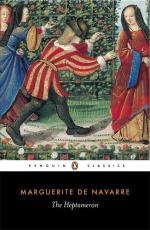Few ladies have been known in history by more and more confusing titles than the author of the Heptameron, the confusion arising partly from the fact that she had a niece and a great-niece of the same charming Christian name as herself. The second Margaret de Valois (the most appropriate name of all three, as it was theirs by family right) was the daughter of Francis I., the patroness of Ronsard, and, somewhat late in life, the wife of the Duke of Savoy—a marriage which, as the bride carried with her a dowry of territory, was not popular, and brought some coarse jests on her. Not much is said of her personal appearance after her infancy; but she inherited her aunt’s literary tastes, if not her literary powers, and gave Ronsard powerful support in his early days. The third was the daughter of Henry II., the “Grosse Margot” of her brother, Henry III., the “Reine Margot” of Dumas’ novel, the idol of Brantome, the first wife of Henry IV., the beloved of Guise, La Mole, and a long succession of gallants, the rival of her sister-in-law Mary Stuart, not in misfortunes, but as the most beautiful, gracious, learned, accomplished, and amiable of the ladies of her time. This Margaret would have been an almost perfect heroine of romance (for she had every good quality except chastity), if she had not unluckily lived rather too long.
Her great-aunt, our present subject, was not the equal of her great-niece in beauty, her portraits being rendered uncomely by a portentously long nose, longer even than Mrs. Siddons’s, and by a very curious expression of the eyes, going near to slyness. But the face is one which can be imagined as much more beautiful than it seems in the not very attractive portraiture of the time, and her actual attractions are attested by her contemporaries with something more than the homage-to-order which literary men have never failed to pay to ladies who are patronesses of letters. Besides Margaret of Valois, she is known as Margaret of Angouleme, from her place of birth and her father’s title; Margaret of Alencon, from the fief of her first husband; Margaret of Navarre, of which country, like her grand-niece, she was queen, by her second marriage with Henry d’Albret; and even Margaret of Orleans, as belonging to the Orleans branch of the royal house. She was not, like her nieces, Margaret of France, as her father never reigned, and Brantome properly denies her the title, but others sometimes give it. When it is necessary to call her anything besides the simple “Margaret,” Angouleme is at once the most appropriate and the most distinctive designation. She was born on the 11th or 12th of April 1492, her father being Charles, Count of Angouleme, and her mother Louise of Savoy. She was their eldest child, and two years older than her brother, the future King Francis. According to, and even in excess of, the custom of the age, she received a very learned education, acquiring not merely the three tongues, French, Italian, and Spanish, which were all in common




